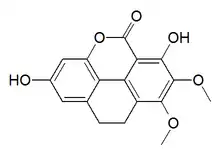 Chemical structure of coeloginin | |
| Names | |
|---|---|
| Preferred IUPAC name
2,6-Dihydroxy-7,8-dimethoxy-9,10-dihydro-5H-phenanthro[4,5-bcd]pyran-5-one | |
| Identifiers | |
3D model (JSmol) |
|
| ChemSpider | |
PubChem CID |
|
| UNII | |
| |
| |
| Properties | |
| C17H14O6 | |
| Molar mass | 314.293 g·mol−1 |
Except where otherwise noted, data are given for materials in their standard state (at 25 °C [77 °F], 100 kPa).
Infobox references | |
Coeloginin is a phenanthrenoid found in the high altitude Himalayan orchid Coelogyne cristata. This molecule has a phenanthro[4,5-bcd]pyrone structure.[1][2]
References
- ↑ Majumder, Priyalal; Bandyopadhyay, Debabrata; Joardar, Subhendu (1982). "Coelogin and coeloginin: Two novel 9,10-dihydrophenanthrene derivatives from the orchid Coelogyne cristata". Journal of the Chemical Society, Perkin Transactions 1: 1131. doi:10.1039/P19820001131.
- ↑ Majumder, P. L.; Sen, S.; Majumder, S. (2001). "Phenanthrene derivatives from the orchid Coelogyne cristata". Phytochemistry. 58 (4): 581–6. doi:10.1016/S0031-9422(01)00287-4. PMID 11576602.
This article is issued from Wikipedia. The text is licensed under Creative Commons - Attribution - Sharealike. Additional terms may apply for the media files.